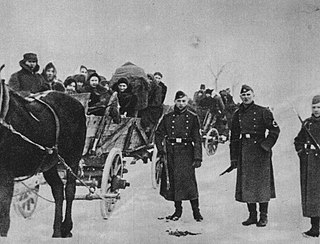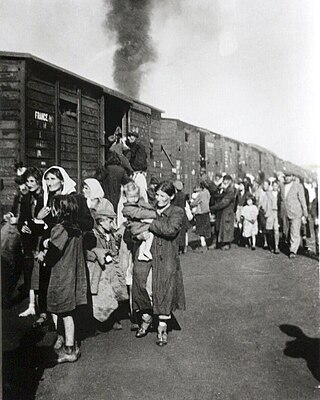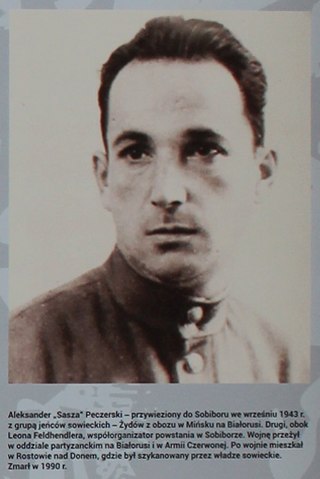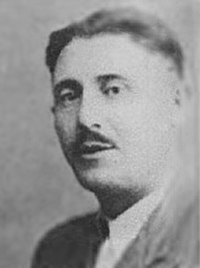
Belzec was a Nazi German extermination camp in occupied Poland. It was built by the SS for the purpose of implementing the secretive Operation Reinhard, the plan to murder all Polish Jews, a major part of the "Final Solution", the overall Nazi effort to complete the genocide of all European Jews. Before Germany's defeat put an end to this project more than six million Jews had been murdered in the Holocaust. The camp operated from 17 March 1942 to the end of June 1943. It was situated about 500 m (1,600 ft) south of the local railroad station of Bełżec, in the new Lublin District of the General Government territory of German-occupied Poland. The burning of exhumed corpses on five open-air grids and bone crushing continued until March 1943.

Operation Reinhard or Operation Reinhardt was the codename of the secret German plan in World War II to exterminate Polish Jews in the General Government district of German-occupied Poland. This deadliest phase of the Holocaust was marked by the introduction of extermination camps. The operation proceeded from March 1942 to November 1943; about 1.47 million or more Jews were murdered in just 100 days from late July to early November 1942, a rate which is approximately 83% higher than the commonly suggested figure for the kill rate in the Rwandan genocide. In the time frame of July to October 1942, the overall death toll, including all killings of Jews and not just Operation Reinhard, amounted to two million killed in those four months alone. It was the single fastest rate of genocidal killing in history.

Sobibor was an extermination camp built and operated by Nazi Germany as part of Operation Reinhard. It was located in the forest near the village of Żłobek Duży in the General Government region of German-occupied Poland.

Majdanek was a Nazi concentration and extermination camp built and operated by the SS on the outskirts of the city of Lublin during the German occupation of Poland in World War II. It had seven gas chambers, two wooden gallows, and some 227 structures in all, placing it among the largest of Nazi concentration camps. Although initially intended for forced labor rather than extermination, it was used to murder people on an industrial scale during Operation Reinhard, the German plan to murder all Polish Jews within their own occupied homeland. In operation from 1 October 1941 to 22 July 1944, it was captured nearly intact. The rapid advance of the Soviet Red Army during Operation Bagration prevented the SS from destroying most of its infrastructure, and Deputy Camp Commandant Anton Thernes failed to remove the most incriminating evidence of war crimes.

Operation Harvest Festival was the murder of up to 43,000 Jews at the Majdanek, Poniatowa and Trawniki concentration camps by the SS, the Order Police battalions, and the Ukrainian Sonderdienst on 3–4 November 1943.

Escape from Sobibor is a 1987 British television film which aired on ITV and CBS. It is the story of the mass escape from the Nazi extermination camp at Sobibor, the most successful uprising by Jewish prisoners of German extermination camps. The film was directed by Jack Gold and shot in Avala, Yugoslavia. The full 176-minute version shown in the UK on 10 May 1987 followed a 143-minute version shown in the United States on 12 April 1987.

Thomas "Toivi" Blatt was a Holocaust survivor, writer of mémoires, and public speaker, who at the age of 16 escaped from the Sobibór extermination camp during the uprising staged by the Jewish prisoners in October 1943. The escape was attempted by about 300 inmates, many of whom were recaptured and killed by the German search squads. Following World War II Blatt lived in Communist Poland until the Polish October. In 1957, he emigrated to Israel, and in 1958 settled in the United States.

Jewish resistance under Nazi rule took various forms of organized underground activities conducted against German occupation regimes in Europe by Jews during World War II. According to historian Yehuda Bauer, Jewish resistance was defined as actions that were taken against all laws and actions acted by Germans. The term is particularly connected with the Holocaust and includes a multitude of different social responses by those oppressed, as well as both passive and armed resistance conducted by Jews themselves.

Alexander "Sasha" Aronovich Pechersky, also known as Oleksandr Aronovych Pecherskyi, was a Jewish-Soviet officer. He is one of the organizers, and the leader, of the most successful uprising and mass-escape of Jews from a Nazi extermination camp during World War II, which occurred at the Sobibor extermination camp on 14 October 1943.

The Trawniki concentration camp was set up by Nazi Germany in the village of Trawniki about 40 kilometres (25 mi) southeast of Lublin during the occupation of Poland in World War II. Throughout its existence the camp served a dual function. It was organized on the grounds of the former Polish sugar refinery of the Central Industrial Region, and subdivided into at least three distinct zones.

Dov Freiberg born Berek Freiberg, was a Holocaust survivor, writer, and witness at the Eichmann trial and the Demjanjuk case. Freiberg was a prisoner at Sobibor extermination camp where he participated in the Sobibor uprising. After the revolt, he managed to escape into nearby woods and survived until the Soviet Army entered in July 1944.

The Majdanek State Museum is a memorial museum and education centre founded in the fall of 1944 on the grounds of the Nazi Germany Majdanek death camp located in Lublin, Poland. It was the first museum of its kind in the world, devoted entirely to the memory of atrocities committed in the network of concentration, slave-labor, and extermination camps and subcamps of KL Lublin during World War II. The museum performs several tasks including scholarly research into the Holocaust in Poland. It houses a permanent collection of rare artifacts, archival photographs, and testimony.

The Sobibór Museum or the Museum of the Former Sobibór Nazi Death Camp, is a Polish state-owned museum devoted to remembering the atrocities committed at the former Sobibor extermination camp located on the outskirts of Sobibór near Lublin. The Nazi German death camp was set up in occupied Poland during World War II, as part of the Jewish extermination program known as the Operation Reinhard, which marked the most deadly phase of the Holocaust in Poland. The camp was run by the SS Sonderkommando Sobibor headed by Franz Stangl. The number of Jews from Poland and elsewhere who were gassed and cremated there between April 1942 and 14 October 1943 is estimated at 250,000; possibly more, including those who came from other Reich-occupied countries.

During World War II, Trawniki men were Eastern European Nazi collaborators, consisting of either volunteers or recruits from prisoner-of-war camps set up by Nazi Germany for Soviet Red Army soldiers captured in the border regions during Operation Barbarossa launched in June 1941. Thousands of these volunteers served in the General Government territory of German-occupied Poland until the end of World War II. Trawnikis belonged to a category of Hiwis, Nazi auxiliary forces recruited from native subjects serving in various jobs such as concentration camp guards.

Rudolf Reder a.k.a. Roman Robak was one of only two survivors of the Bełżec extermination camp. His testimony after the war became very well known. He submitted a deposition to the Main Commission for the Investigation of German Crimes in January 1946 in Kraków. In terms of the number of Polish Jews who perished in its gas chambers, Bełżec had the third highest death toll among the six Nazi death camps located in occupied Poland, estimated between 500,000 and 600,000 men, women and children. Only Auschwitz-Birkenau and Treblinka killed more people during the Holocaust.

Többens and Schultz was a Nazi German textile manufacturing conglomerate making German uniforms, socks and garments in the Warsaw Ghetto and elsewhere, during the occupation of Poland in World War II. It was owned and operated by two major war profiteers: Fritz Emil Schultz from Danzig, and a convicted war criminal, Walter C. Többens.

Stanisław "Szlomo" Szmajzner was one of 58 known survivors of the Sobibór extermination camp in German-occupied Poland and participated in the 1943 camp-wide revolt and escape from Sobibór. He was born in Puławy, Poland and died in Goiânia, Brazil.

The Sobibor uprising was a revolt of about 600 prisoners that occurred on 14 October 1943, during World War II and the Holocaust at the Sobibor extermination camp in occupied Poland. It was the second uprising in an extermination camp, partly successful, by Jewish prisoners against the SS forces, following the revolt in Treblinka.



















